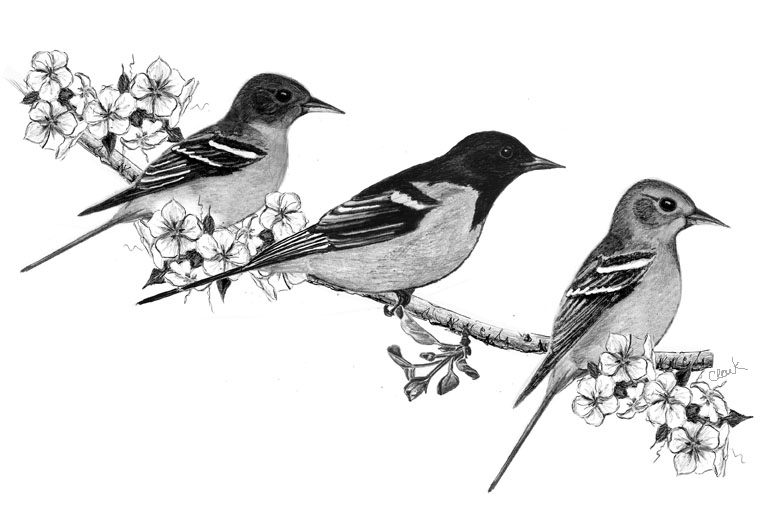
Dear Bird Folks,
As you promised, the orioles we saw on our feeder in May (but seemed to disappear in June) have returned big time. Now we have more than we can count. We are wondering how we can tell the duller female orioles from their fledglings.
– Rita, Simsbury, CT
Let’s start with the easy one first, Rita,
We’ll get to the tough part later. By the time he is two years old, the male Baltimore Oriole is one of the most distinctive birds in eastern North America. His brilliant colors are the reason the oriole was chosen as the state bird of Maryland. Being a state bird should be a terrific honor, except Maryland also has, of all things, a state cat. A state cat? Give me a break. And they have a state dinosaur, too. When I first heard about all these weird state items, I began to think the Marylanders had lost their minds…until I read about their state dessert, which is a cake that has up to fifteen layers (yes, you read that right) of frosting. Now I think the folks in Maryland are geniuses. By comparison, the state dessert of Massachusetts is the Boston cream pie, which is delicious, but it only has two layers. How embarrassing. Good job, MD.
With some birds, telling the sexes apart is ridiculously easy. For example, a breeding pair of Scarlet Tanagers is so dissimilar (the male is bright red and the female is yellow) they don’t even look like the same species. Conversely, birds such as Blue Jays, catbirds and chickadees are so identical I don’t know how the birds themselves can tell which is which. With Baltimore Orioles, things are a little trickier. Older males are not a problem; they have the classic orange and black coloring we all imagine when we think of orioles. If you’ve seen one male, you’ve seen them all. This is not the case with the ladies; their plumages are extremely variable. One female may be rather dull, while the female next door is brighter and showier…and she knows it.
Things become even muddier after the babies fledge. Now we have lots of dull orioles in the yard and separating the mother from her offspring is not always easy. A few weeks ago I was having this same discussion with Eddie, a long-time birder who loves to tease me about all the bluebirds he has nesting in his yard, while I have none. (I hate Eddie.) When he mentioned also getting lots of young orioles, I asked him how he sorts out the kids from the moms. His advice was to look at their faces. Most adult females will have some dark on their faces, with a few having nearly as much black as the males have. The faces of the baby birds, however, are mostly light gray-brown. When I got home I studied the orioles coming to my feeder and sure enough, Eddie was right. I guess I shouldn’t hate him so much after all.
If sorting out the face coloring doesn’t work for you, the next step is to watch the bird’s behavior. No matter the plumage, a mature bird will arrive on a feeder with an air of confidence, while an immature bird will act, well, immature. In my yard the kids typically land on the feeder awkwardly, often upside down, poking their beaks at everything they see, including the bracket and the post. They also squawk constantly, quivering their wings and begging from any bird that makes eye contact with them. FYI: For anyone new to feeding birds, I should point out that orioles readily come to feeders offering orange halves, or grape jelly or sugar water in specially made hummingbird-style feeders. And, if you live in Maryland, they’ll also come to your yard for a slice of cake made with fifteen layers of frosting…or at least they should.
With so many customers reporting so many orioles on their feeders right now, it would seem the oriole population is exploding, but, unfortunately, such is not the case. Orioles are actually declining in many areas. One likely reason for their decline is loss of habitat at their tropical wintering grounds. When farmers remove trees in order to grow, say, coffee, the birds lose out. (Thanks a lot, Dunkin’.) I know drinking “shade grown coffee” sounds gimmicky, but it actually benefits the birds. Really.
While we might not be able to control things in the tropics, we can do a better job of managing our own microhabitats. Each evening after work, I would sit on my back deck and watch both the male and female oriole scour the outer branches of our trees, particularly the oaks, frantically searching for some wormy thing to carry back to their nest. The trees in my yard are always busy with birds because it’s one of the few yards in the neighborhood that hasn’t had the life landscaped out of it. Keeping our trees natural and free of pesticides is important, but a natural lawn is equally critical. We might not realize it, but many of the insects that birds depend upon spend part of their life underground. Every time a lawn is “treated,” there are fewer treats for baby birds to eat.
It would be nice if all female Baltimore Orioles looked the same, Rita, because their variations can make identification tricky. When it comes to the young birds, the key, according to Eddie, is the lighter coloring on the face and head, plus less orange and more yellow on the body. Oddly, with some females, their head plumage actually becomes darker with age. Darker with age, eh? I wish I could say the same thing about my own head plumage.